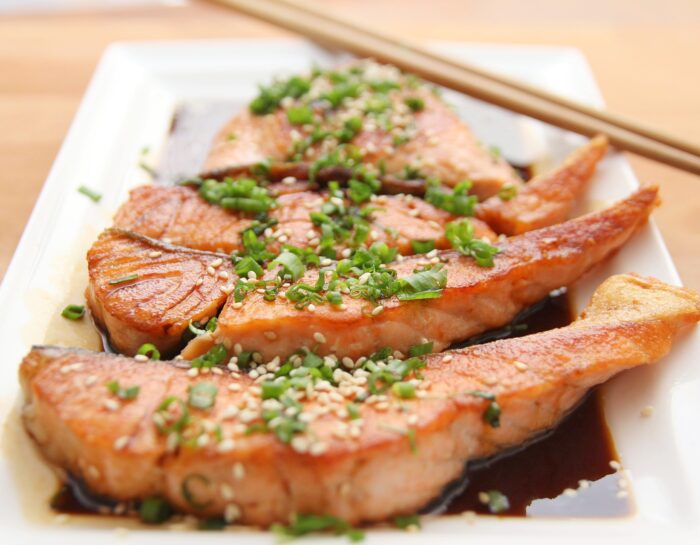By Chef Murph
Overview of Dash Diet:
Unlike many diets on the market, the DASH diet was not developed as a weight loss program. The DASH (Dietary Approaches to Stop Hypertension) Eating Plan was developed as a treatment for Hypertension. It just so happens that weight loss was one of the unexpected side effects. In addition to high blood pressure, it is also helpful in prevention of osteoporosis, cancer, heart disease, stroke, and diabetes.
program. The DASH (Dietary Approaches to Stop Hypertension) Eating Plan was developed as a treatment for Hypertension. It just so happens that weight loss was one of the unexpected side effects. In addition to high blood pressure, it is also helpful in prevention of osteoporosis, cancer, heart disease, stroke, and diabetes.
This a diet low on saturated fats, cholesterol and total fat; it’s also confined to around 2,000 calories a day with a number of restrictions.
There are two versions of this diet, the Standard and Low sodium versions.
1.The Standard version allows for about 2,300mg of sodium
2.The Low Sodium version allows for 1,500mg of sodium daily.
What Can You Eat On The Dash Diet?
So what exactly can you eat while participating in the DASH program? Well this diet places a heavy emphasis on vegetables, fruit, and low-fat dairy foods; as well as a moderate emphasis on who grains, fish, poultry, legumes, and nuts.
Red Meat
Surprisingly you are allowed to have red meats, fats, and even sweets in small amounts. This diet is more about moderation than deprivation.
Meats And Fish
You are allowed 6 or fewer servings of lean meats, poultry, and fish daily. These meats are rich in protein, B Vitamins, iron, and zinc. However, since meat contains fat and cholesterol they must be consumed in moderation.
Examples of a serving include 1oz cooked skinless, poultry, seafood, lean meat, or 1 egg. You are encouraged to trim away the skin before preparing your meats. Accepted methods of preparation are baking, broiling, grilling, or roasting. You aren’t allowed to fry as that increases the fat content.
There are certain types of fish that are better than others are. Salmon, herring, and tuna are good examples of heart healthy fish. They are rich in Omega 3 fatty acids, which are good for lowering cholesterol.
Whole Grains
You’re expected to have 6 to 8 servings of grains a day. This includes bread, cereal, and pasta. Examples of a serving would be 1 slice of whole-wheat bread, or one half cup of rice or cereal. This diet is big on fiber so try to shift your focus to whole grains, as they are richer in fiber and nutrients than refined grains. Brown rice over white, whole-wheat pasta over regular pasta, etc.
Vegetables
You are expected to eat 4 to 5 servings of vegetables daily including tomatoes, greens, carrots and other fiber rich vegetables. You want to have vegetables rich in minerals such as potassium and magnesium. Examples of serving include 1 cup of raw leafy green vegetables or ½ cup of cut-up raw or cooked vegetables.
Try not to think of your vegetables as exclusively side dishes. Try to get creative with your vegetable based dishes to keep you interest. Try blending vegetables with brown rice or whole-wheat noodles. Vegetables can make great whole meals with a bit of imagination.
Fruits
You are expected eat 4 to 5 servings a day with a heavy emphasis on fruits rich in potassium and magnesium like bananas. Examples of a serving include 1 medium sized piece of fruit, ½ cup of fresh, frozen, or canned fruit or 4 ounces of pure fruit juice.
Dairy
You must avoid added butter and cream. However, you are allowed 2 to 3 servings of dairy per day. Most dairy products are rich in fat so you should go easy on these foods and avoid daily consumption. Dairy foods you are allowed include milk, yogurt, cheese, and low-fat alternatives. Examples of a serving are 1 cup of skim or 1 percent milk, 1 cup of yogurt or 1 ½ oz. cheese. Low-fat or fat-free frozen yogurt can be substituted for you cup of normal yogurt. If you eat frozen yogurt you can have a bit more. This allows you to have larger portions while satisfying your sweet tooth.
If you find that you have difficulty digesting lactose you should substitute lactose free products. You may also want to consider the use of over the counter medications that aid in the digestion of lactose. Dairy is a major source of calcium, vitamin D, and protein. Consuming dairy is important to maintaining healthy levels of these nutrients in your diet.
Nuts And Legumes
Nuts, seeds, and legumes are also allowed at 4 to 5 servings per week. Choose from kidney beans, peas, almonds, lentils and others. All of these are good sources of protein, magnesium, and potassium. They are also rich in Phytochemicals, which are plant compounds that help protect against cancers and cardiovascular disease. You are encouraged to keep the consumption of these foods low, as they are high on calories.
Sweets
Surprisingly you are allowed sweets, 5 or fewer a week, provided they are low fat. Examples of allowed sweets are frozen ices, sorbets, graham crackers and other low fat options. Artificial sweeteners are strictly prohibited.
Long Term Success
You want to gradually change your habits. If you are not used to eating whole grains, substitute a few whole grains into your diet building up to only whole grains.
If you don’t have much fiber in your diet slowly, build up to reduce the feeling of bloating and gas associated with a high fiber diet. With this diet, your focus is long-term change, not a quick fix. You are encouraged to slowly add physical activity, maybe a weekly walk building up to a run or daily walk. You are also encouraged to reward the small successes with non-food related treats such as a movie or that new shirt you had your eye on.
Also, keep in mind that everyone slips up. If you slip up during the diet process, try to figure out what caused it and learn from it; then pick up where you left off.
Bottom Line
The DASH diet is a comprehensive diet that focuses on new and healthy lifestyle changes above all else. This well-rounded approach makes this particular diet one focused on long-term success rather than short-term results. In short, this diet covers all the bases to increase its effectiveness.
Tags: Chef K.T. Murphy, chef keith murphy, chef murph, Chef Murph TV, Chef Murphy, Chinese, Dash Diet, food, Foodist Networks, Global Fusion Americana, Recipes
